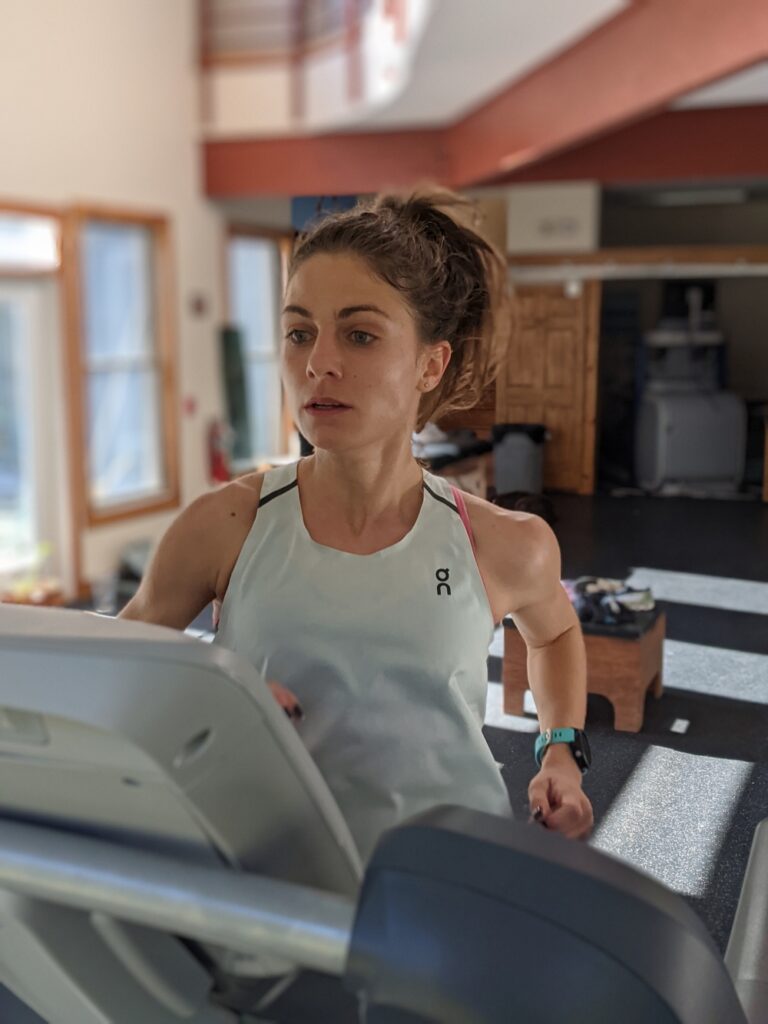Given the choice the vast majority of us would rather run outside on the roads or trails, feel the wind in our face and watch the scenery go by rather than be relegated to the treadmill. I get it. But with little daylight and slick footing, treadmill running in the winter can be a brilliant tool for quality training. And for many with hectic schedules, it can be a necessity year round.
This winter stop thinking about the treadmill as the “dreadmill” and embrace the machine that can make us better runners. There are countless examples of professional athletes using treadmills to improve the quality of training by avoiding inclement weather, improving the specificity of a workout, and other purposes that we all can take advantage of.

Treadmill Running Adjustments
There is a common notion that running on a treadmill changes running gait. However, research has shown there to be no practical difference between running outside and running on a treadmill. If you rarely run on a treadmill, you may find the pace initially feels quicker than the same speed outside. However, this sensation is more perception than reality.
Running fast on the treadmill does have a different sensation that running outside. Once you get used to it you’ll find the treadmill feels similar, or even a bit easier, to running outside. At speeds slower than 7:30 – 8:00 minutes per mile there is research to suggest the speed on the treadmill is of equal effort to the same speed outside. For the speedier among us, running at 7:00 – 7:30 pace or quicker, the wind resistance experienced running outside has a greater impact so adjusting the treadmill to a 1% incline most closely mimics the effort to running outside.
Treadmill Running to Reduce Risk
In the winter the treadmill is a way to avoid treacherous surfaces outside. While many of us would prefer to layer up and get outside there are times that decision can increase your injury risk. When the footing is poor because of wintery conditions or you can’t see where your feet are landing because it’s dark, the risk of injury increases dramatically. I have seen countless runners go out in snowy or icy conditions and come back with achilles, hamstring, calf, and hip flexor injuries due to slipping and sliding every step. And that’s notwithstanding the injury risk due to slipping and falling.
Treadmill Running for Heat Acclimation
On the opposite end of the spectrum, the treadmill can be used for acclimating to warmer temperatures. This is particularly helpful for spring races that have the potential to be unseasonably warm. An unseasonably warm race day in the spring can be particularly problematic. As opposed to the fall, you haven’t spent the entire summer getting used to the heat. Rather, you’ve spent the entire winter getting used to the cold. With every passing day in spring, there is an increasing chance that the warmest day of the year is going to be your race day. By doing some indoor treadmill running you can improve your ability to deal with an unseasonably warm day.
Treadmill Running for Course Specific Workouts
Climate control is not the only time treadmill running can be an opportunity rather than relegation. Being forced to it in the winter can be the gateway to exploring other benefits of treadmill running. Treadmill running allows for greater control over the specificity of a run. One area where this is particularly useful is for course specific preparation.
For example, training for the Boston Marathon (in non-pandemic years) starts in the winter months. The first 16 miles of rolling downhill at Boston beat up your legs. In order to prepare properly for that challenge you should plan on doing some specific preparation. Doing a long run where the first 10-12 miles are predominately downhill is a logistical challenge for many. However, on a treadmill you can control for it with either a negative incline. Using the same principle you can prepare for any type of course more specifically than you often can outside.
Treadmill Running Workouts
Similarly, the treadmill allows you to do workouts that might otherwise be challenging logistically. The winter is a perfect time for incorporating hill training into your routine. Hills help build strength and improve efficiency ahead of more specific workouts for spring and summer racing. Our head coach at On ZAP Endurance, Pete Rea, uses the treadmill for a unique workout called “minute-minute-minute cycles.”
This workout is a sustained uphill climb that starts 30-40 seconds per mile slower than marathon pace at an incline of 1%. To execute it, start by running that pace for 1 minute. For the 2nd minute pick the pace up .1 mph and increase the incline to 2%. For the 3rd minute bump the pace another .1mph and the incline to 3%. After the 3rd minute go right back to the 1st minute and repeat the sequence up to 2-3 times before moving on to the next 3 minute sequence. Start the next 3 minute sequence .1 mph faster than the previous sequence. You can do up to 5-6 three minute sequences following the same pattern. Not only does it provide a great uphill workout, but all that button pushing makes the time go by quickly on the treadmill.
Get away from the “dreadmill” mindset this winter. Use the treadmill as an opportunity to take on new challenges and put in a winter of training that supports big spring goals!